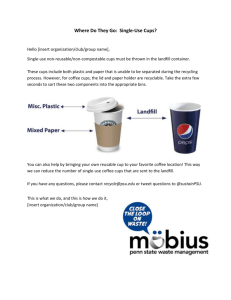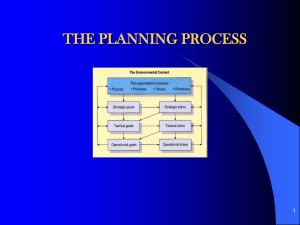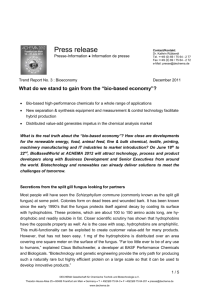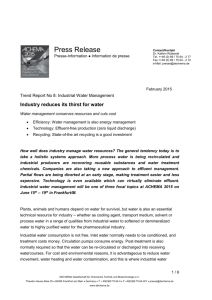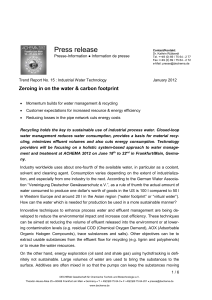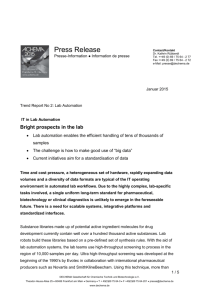doc - Achema
advertisement
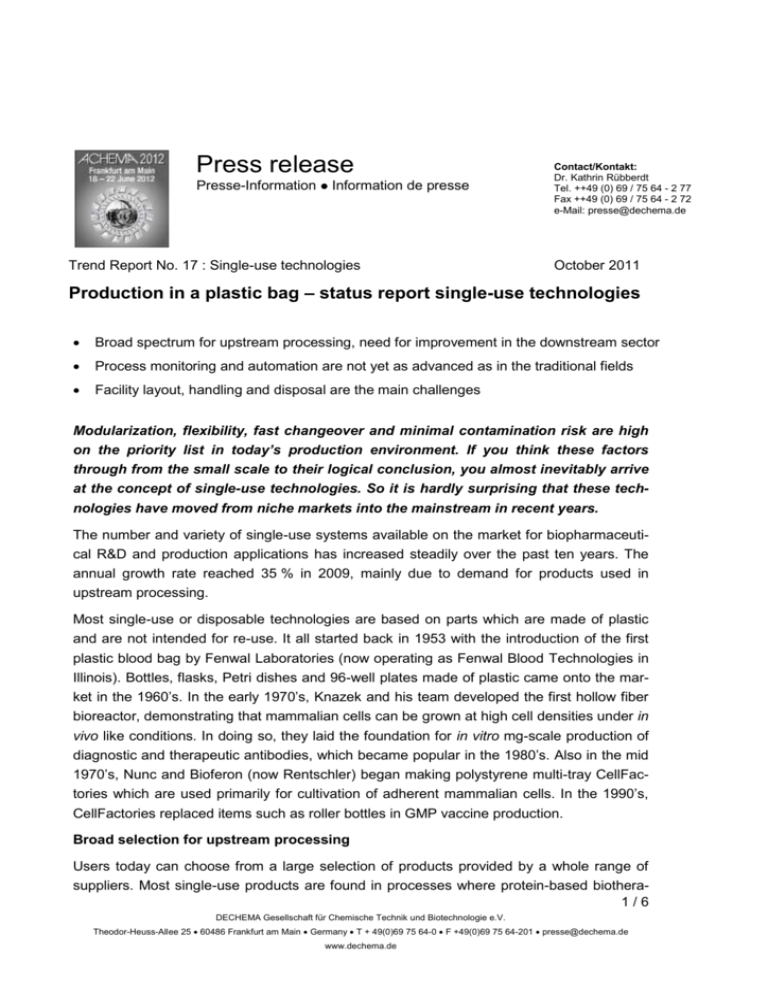
Press release Presse-Information Information de presse Trend Report No. 17 : Single-use technologies Contact/Kontakt: Dr. Kathrin Rübberdt Tel. ++49 (0) 69 / 75 64 - 2 77 Fax ++49 (0) 69 / 75 64 - 2 72 e-Mail: presse@dechema.de October 2011 Production in a plastic bag – status report single-use technologies Broad spectrum for upstream processing, need for improvement in the downstream sector Process monitoring and automation are not yet as advanced as in the traditional fields Facility layout, handling and disposal are the main challenges Modularization, flexibility, fast changeover and minimal contamination risk are high on the priority list in today’s production environment. If you think these factors through from the small scale to their logical conclusion, you almost inevitably arrive at the concept of single-use technologies. So it is hardly surprising that these technologies have moved from niche markets into the mainstream in recent years. The number and variety of single-use systems available on the market for biopharmaceutical R&D and production applications has increased steadily over the past ten years. The annual growth rate reached 35 % in 2009, mainly due to demand for products used in upstream processing. Most single-use or disposable technologies are based on parts which are made of plastic and are not intended for re-use. It all started back in 1953 with the introduction of the first plastic blood bag by Fenwal Laboratories (now operating as Fenwal Blood Technologies in Illinois). Bottles, flasks, Petri dishes and 96-well plates made of plastic came onto the market in the 1960’s. In the early 1970’s, Knazek and his team developed the first hollow fiber bioreactor, demonstrating that mammalian cells can be grown at high cell densities under in vivo like conditions. In doing so, they laid the foundation for in vitro mg-scale production of diagnostic and therapeutic antibodies, which became popular in the 1980’s. Also in the mid 1970’s, Nunc and Bioferon (now Rentschler) began making polystyrene multi-tray CellFactories which are used primarily for cultivation of adherent mammalian cells. In the 1990’s, CellFactories replaced items such as roller bottles in GMP vaccine production. Broad selection for upstream processing Users today can choose from a large selection of products provided by a whole range of suppliers. Most single-use products are found in processes where protein-based biothera1/6 DECHEMA Gesellschaft für Chemische Technik und Biotechnologie e.V. Theodor-Heuss-Allee 25 60486 Frankfurt am Main Germany T + 49(0)69 75 64-0 F +49(0)69 75 64-201 presse@dechema.de www.dechema.de peutics made from mammalian cells are the target products. With the broad spectrum of components, sensors and single-use pumps which are available, complete single-use upstream processing for culture volumes up to 2 m3 is now feasible. The range of options includes bioreactors which use wave motion to mix materials (GE Healthcare’s Wave Bioreactor and Biostat CultiBag RM from Sartorius Stedim Biotech) as well as single-use stirred bioreactors available in a variety of versions (e.g. rigid plastic tanks from Mobius CellReady, UniVessel SU and CelliGEN BLU and flexible bag systems from S.U.B., Biostat CultiBag STR and XDR Bioreactor). The size, the underlying principle of operation and mixing as well as the instrumentation vary on these systems, and they all have their own defined fluid dynamics. For repetitive steps (mixing, storage, material handling, inoculant production, fermentation and biomass separation), basic operation sets have been consolidated into process platforms. These platforms are technical implementations which combine a well-defined sequence of processes or process steps. A number of these platforms are now available for media production, fermentation and biomass separation. The size of the systems as well as the number and sequence of process steps vary. There are technical limitations to the deployment of single-use technologies in upstream processing due to the plastics which are contained in the products. The list of limitations includes stability, applications spectrum, scale-up and handling. The current size limits from the user perspective are in the 1,000-2,000 liter range for bag volumes and 30 inches for filter cartridges, even if suppliers offer larger bag systems (up to 5,000 liters). Above these thresholds, users currently install multiple systems in parallel when they need to increase capacity. Recent surveys by Aspen Brook Consulting indicate that 80 % of users regard this approach as adequate. More work to do in downstream processing Despite the fact that the increasing deployment of single-use systems in upstream processing has led to the development of similar systems for downstream processing, the latter are not as significant a factor as the upstream systems. The basic downstream processing steps used in the production of biopharmaceutical products include conventional filtration and chromatographic techniques as well as recent developments such as functional filtration/absorption and mixed-mode technologies. The term mixed-mode refers to a multiple retention mechanism which forms the basis for interactions between the target and the sorbent. In contrast, the filling process for the formulated end product in biopharmaceutical production normally involves conventional fluid transfer with or without final lyophilization. From the available set of basic operations, the most suitable methods for product isolation and purification are selected and combined to form a sequence. The sequence and quality of the methods chosen varies depending on the properties and quality requirements of the product which is being purified. 2/6 DECHEMA Gesellschaft für Chemische Technik und Biotechnologie e.V. Theodor-Heuss-Allee 25 60486 Frankfurt am Main Germany T + 49(0)69 75 64-0 F +49(0)69 75 64-201 presse@dechema.de www.dechema.de As is the case in upstream processing, single-use technologies offer a number of advantages compared to conventional reusable systems: (1) lower investment costs, (2) shorter development and implementation times, (3) reduced qualification and maintenance effort and (4) increased flexibility. Nevertheless, there is more work to do in downstream processing. Disposable mixers with capacities up to 1,000 liters and disposable versions of conventional microfiltration (0.1/0.2 µm) and depth filtration systems have already established a foothold, but ultrafiltration remains a bottleneck. Chromatographic systems are a different story altogether. The cost of chromatography gels offsets the advantages of prepackaged, ready-to-use columns (i.e. greater flexibility and a reduction in the time and effort involved). Currently, disposable chromatographic systems are not an attractive option for processes that involve frequent harvesting and purification in columns which have a long service life. Efforts are currently underway to develop single-use technologies which enhance process performance and reduce cost. One example is the use of mixed-mode sorbents and sequential chromatography. The objective is to reduce chromatography media consumption by developing new protein capture selectivity and increasing utilization efficiency. The slow rate of progress in chromatography has led to the development of alternative purification techniques. Functional filtration using membrane adsorbers combines the advantages of single-use filtration and functional surfaces, particularly those with ion exchanger and affinity properties. They are designed right from the outset as single-use systems. Nevertheless, according to Detlef Eisenkrätzer, Roche, the lack of low-cost alternatives to reusable affinity chromatography columns is one of the greatest impediments to the deployment of single-use technologies. Monitoring and automation In terms of process monitoring and automation functionality, single-use systems are not yet fully on a par with competing systems. They are supplied with in situ and ex situ sensors. In situ sensors, which come into contact with the culture medium, must be sterilizable. Ex situ sensors based on non-invasive optical technology, where sensors collect data through transparent windows, or conventional sensors placed in a sample flow outside the sterile barrier do not require sterilization. A number of systems are available for detecting process variables such as pressure, temperature and to some extent pH and pO2, so detection of these variables is not a problem. However the selection of instrumentation for analysis of other process parameters is limited to systems offered by suppliers for integration into their own product. In effect this means that the selection of the single-use system supplier determines what analysis instrumentation will be available. 3/6 DECHEMA Gesellschaft für Chemische Technik und Biotechnologie e.V. Theodor-Heuss-Allee 25 60486 Frankfurt am Main Germany T + 49(0)69 75 64-0 F +49(0)69 75 64-201 presse@dechema.de www.dechema.de Obstacles in the path of single-use technologies Process characterization and standardization of single-use systems are still inadequate both in upstream and downstream processing. Others limitations of single-use systems apply to pressure, flow rates, centrifugal force, temperature and O 2/CO2 stripping rates. The list of constraints also includes the limited set of leachables and extractables, size limits, the higher cost of consumables, security of supply issues and the current lack of automation sensors. In addition, successful implementation of single-use technologies also depends on changes and new approaches to system design, employee training, quality assurance and production flows, all of which have to start back in the development phase. However despite all of that, the products which are already available on the market, when used and handled properly, provide a route to smaller, cheaper, greener, safer and faster development and production. That undoubtedly explains why these systems have established a firm foothold in all of the main process steps found in small to medium scale production of biopharmaceuticals and biosimilars, particularly in upstream processing. They reduce development cycles and time to market for new biotherapeutics such as antibodies and veterinary and human vaccines. “Especially in vaccine production, we believe that the applications potential is very significant: small volumes, batch production, flexible production requirements and cross-contamination risk. This is an area where single-use technologies can show their strengths,” claims Dr. Karsten Behrend from M+W Process Industries. The majority of biotherapeutics producers (especially contract manufacturers) deploy single-use systems wherever possible. The list of companies in the German speaking region includes Baxter Austria, Boehringer Ingelheim (Germany), Hoffmann La-Roche Germany and Switzerland, Merck Serono Germany and Switzerland, Novartis Switzerland and Austria, Rentschler and Werthenstein BioPharma. As a general rule, hybrid production systems are still the norm at these companies. Singleuse systems are combined with conventional systems made of glass or stainless steel. However, plans are in place to introduce production lines that are fully based on single-use systems. Global developers and manufacturers are included in the general trend towards single-use systems. GE Healthcare, Merck Millipore and Sartorius Stedim Biotech currently have the largest portfolio. However, a lot is going on in development and production. Some new players are entering the market, but experts expect that market consolidation will set in over the coming few years. Companies which have a broad product portfolio and are able to guarantee user support for the entire process will have an advantage. Layout, handling and disposal are the main challenges Facility layout, handling and disposal pose the biggest challenges when users migrate to single-use systems. Facility layout is driven both by company standards and regulatory 4/6 DECHEMA Gesellschaft für Chemische Technik und Biotechnologie e.V. Theodor-Heuss-Allee 25 60486 Frankfurt am Main Germany T + 49(0)69 75 64-0 F +49(0)69 75 64-201 presse@dechema.de www.dechema.de requirements. The potential risk of active ingredient contamination is the primary consideration. The quality of the cleanroom design and the associated HVAC systems has to meet stringent standards. Besides the size of the up-front investment, the ongoing operational cost factor is anything but trivial. Single-use systems normally involve a significant amount of manual intervention. The level of automation on these systems is generally lower than on comparable conventional systems. The complete package used for a process step is often assembled from individual components. In some applications (e.g. when hazardous substances or organisms with high risk potential are involved), overall system integrity should be verified prior to deployment. “Most disposable systems are produced manually, and it is very difficult or impossible to verify integrity at the user site. The customer has no way of determining whether disposable systems have, for example, been damaged in the logistics chain or during handling on site. Problems of this nature could ultimately lead to leakage and contamination or effective loss of the product. Due to the potential losses involved, users may rule out disposable systems right from the start“, explained Jens Kubischik from Pall GmbH Life Sciences. “For that reason, it is absolutely essential to build up a supplier-user relationship which is based on trust and which is reinforced through production process transparency and verification audits.” Disposal is another important aspect of single-use technologies in biopharmaceutical production. Because these systems often contain composites, material separation and sorting become a major challenge. The list of materials involved includes metal parts and a variety of plastics. All of the process steps in some applications are based on single-use systems, and when that is the case waste volumes can be quite considerable. The bags, tubes, filters, etc. which accumulate may be contaminated with organisms and/or chemicals which pose an environmental hazard. These items require treatment prior to disposal. Waste plastic is normally incinerated or sometimes taken to a disposal site. Only a limited range of systems is currently available for shredding and compacting large volumes of waste. There are virtually no systems on the market for waste inactivation/decontamination. In addition, there is no way of locally separating and sorting composites for recycling. As a consequence, an elaborate and costly logistics system is needed, and that can offset the advantages of single-use technologies in process applications. This is a major issue which requires innovative solutions. Material flow strategies will need to be part of the overall plan right from the start. Other industries such as food processing which face similar issues are currently addressing the problem, and it should be possible to adapt those solutions to the biotechnology sector. 5/6 DECHEMA Gesellschaft für Chemische Technik und Biotechnologie e.V. Theodor-Heuss-Allee 25 60486 Frankfurt am Main Germany T + 49(0)69 75 64-0 F +49(0)69 75 64-201 presse@dechema.de www.dechema.de New applications for single-use technologies Growth in the market for disposable systems which are used in the production of proteinbased therapeutic products can be expected to slow down. However if development work continues, the products needed for complete single-use production systems and the “single-use factory in a box” will become closer to reality. “There is already a vision for an SUS container-based vaccine factory which can be shipped anywhere in the world in a very short space of time to produce vaccine (assuming of course the availability of qualified staff),” reported Prof. Regine Eibl from Zurich University of Applied Sciences (ZHAW). We will probably also see new applications of single-use bioreactors (1) in the production of microbial niche products, (2) for production methodologies involving algae and (3) for products in the pharmaceutical, food and cosmetics industries which are based on plant suspension cells, hairy root cultures and mesenchymal tissue. “A large number of 100 % SUSbased implementations of fermentation processes involving animal cell cultures are already established, and more are on the way“, said Detlef Eisenkrätzer from Roche. The latest generation of biotherapeutics will have a decisive influence on the future development of single-use technology. Eibl is convinced that personalized medicine, especially the production of cell therapeutics using stem and T cells, is likely to be one of the most promising future applications of single-use technology. Cell therapeutics are generally regarded as a major product segment in personalized medicine. Products for regenerative medicine (skin, cartilage and bone) have been making their way into the market since the 1990's, and the first customized (person-specific) vaccine for treating prostrate cancer received FDA approval in April 2010. Compared to established manufacturing techniques for protein therapeutics, cell therapy is still in its infancy. Innovative equipment and new technologies will be absolutely essential for commercial success. Given the product requirements and the way the products are used, there is no alternative to single-use systems. More than 200 cell therapeutics for transplant medicine, cancer and aids therapy are currently at the clinical trial stage. This is a great opportunity not only for the medical field but also for single-use technologies. This trend report is based on an extensive status update published by the DECHEMA adhoc Single-Use Technologies Working Group. Among other things, the update provides manufacturer information along with a wealth of details about available products and components. The report will be availabe in English before ACHEMA 2012. www.achema.de (The trend reports are compiled by specialized international journalists. DECHEMA is not liable for incomplete or inaccurate information.) 6/6 DECHEMA Gesellschaft für Chemische Technik und Biotechnologie e.V. Theodor-Heuss-Allee 25 60486 Frankfurt am Main Germany T + 49(0)69 75 64-0 F +49(0)69 75 64-201 presse@dechema.de www.dechema.de
